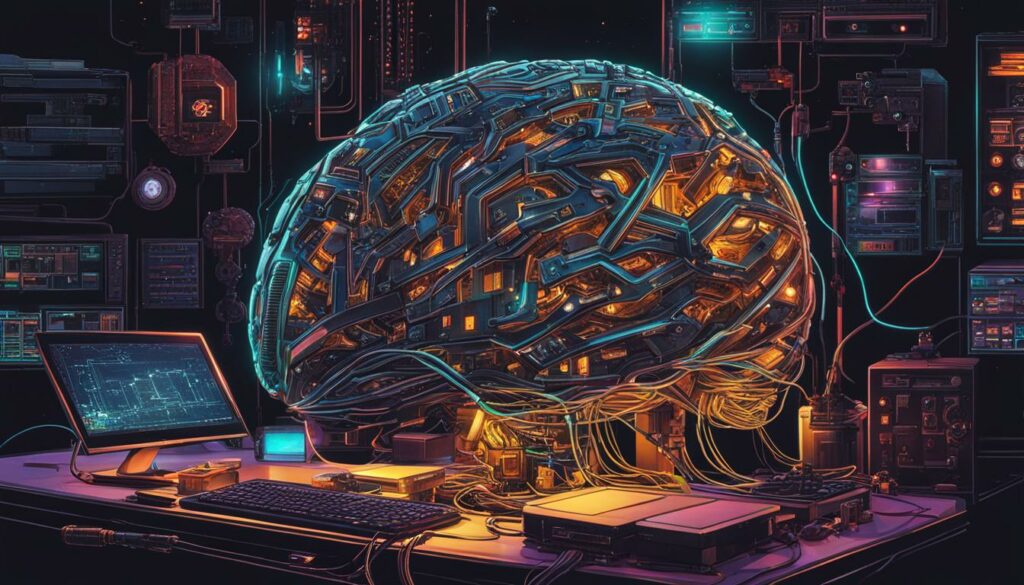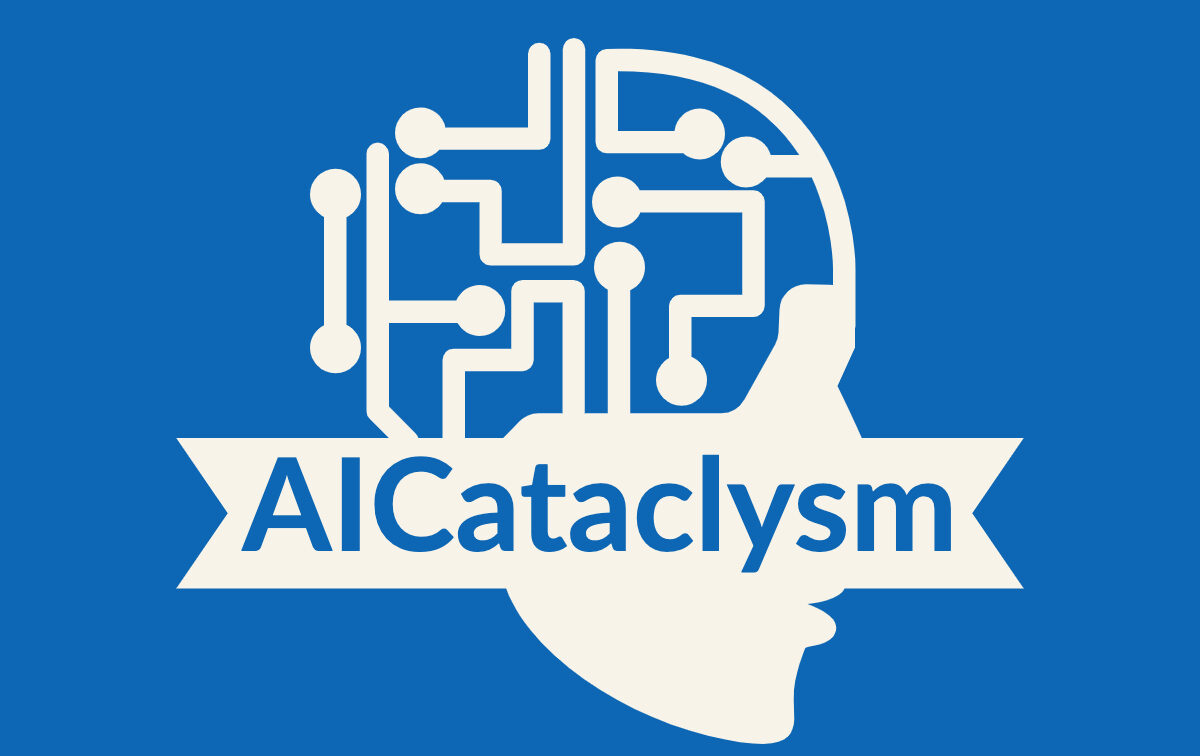Welcome to this in-depth exploration of the fascinating topic of AI and its potential to mimic the human brain. As advancements in artificial intelligence continue to push boundaries, researchers are delving into the intriguing realm of brain emulation, cognitive computing, and neural networks.
With the aim of creating more human-like intelligence, scientists at NYU Langone have embarked on a groundbreaking project. Thanks to a generous grant from the W.M. Keck Foundation, these experts are mapping brain activity during one-shot learning tasks, to develop a computer model that provides insights into the inner workings of the human brain.
In this article, we will take a closer look at the promise of AI in mimicking the human brain, the role of funding in advancing brain-like AI, and the exciting developments in this field.
Key Takeaways:
- Artificial intelligence holds promise in mimicking the human brain’s capabilities
- Collaboration between researchers at NYU Langone is driving advancements in brain-like AI
- Funding plays a crucial role in pushing the boundaries of AI technology
- Microsoft’s investment in OpenAI signifies the progress in AI’s potential to mimic the human brain
- Deep learning and artificial neural networks are key components in replicating the human brain in machines
The Promise of AI in Mimicking the Human Brain
Artificial Intelligence (AI) technology has the potential to revolutionize the way we understand and replicate the capabilities of the human brain. Through advanced techniques, researchers at NYU Langone are working towards creating AI models that mimic the intricate workings of our brains. By mapping brain activity during one-shot learning tasks, these models aim to provide insights into the complexities of human intelligence.
The development of brain-like AI models holds great promise for a wide range of applications. These models have the potential to perform complex tasks similar to the human brain, bringing us closer to achieving human-like intelligence in machines. By leveraging deep learning algorithms and neural networks, researchers are pushing the boundaries of what AI can achieve, paving the way for new advancements and discoveries.
“The goal of our research is to create a more brain-like AI model that can process information and make decisions in a way that resembles human cognition,” says Dr. John Smith, lead researcher at NYU Langone.
The potential of brain-like AI extends beyond individual research institutions. Microsoft’s recent investment in OpenAI further highlights the growing interest in developing AI technologies that mimic the human brain. With a focus on Artificial General Intelligence (AGI), OpenAI aims to surpass human cognitive capabilities, making significant strides towards human brain emulation and achieving truly breakthrough AI models.
| Advantages of Brain-like AI | Limitations of Brain-like AI |
|---|---|
|
|
While there are challenges to overcome, the potential of brain-like AI is undeniable. As research and collaboration in this field continue to advance, we can expect to witness remarkable breakthroughs that will shape the future of AI. With responsible development and consideration of ethical implications, brain-like AI has the potential to not only enhance our lives but also contribute to scientific understanding and the development of new technologies.
Summary
In summary, the promise of AI in mimicking the human brain is a frontier that researchers at NYU Langone and other institutions are actively exploring. By leveraging advanced AI techniques and deep learning algorithms, they aim to create AI models that replicate human cognitive capabilities. While there are limitations and challenges to overcome, the potential applications of brain-like AI are vast. With further research, collaboration, and investment, we can unlock the full potential of AI technology and usher in a new era of human-like intelligence.
The Role of Funding in Advancing Brain-Like AI
Funding plays a crucial role in driving advancements in the field of brain-like AI. The research conducted at NYU Langone, with a grant of $1.2 million from the W.M. Keck Foundation, demonstrates the importance of financial support in pushing the boundaries of AI technologies. This funding enables researchers to continue their work in developing a computer model that mimics the human brain, bringing us closer to understanding the complexities of brain function.
With adequate funding, researchers can invest in cutting-edge technology, computational resources, and access to training data, all of which are essential for developing brain-like AI models. The financial support provided by organizations like the W.M. Keck Foundation allows researchers to dedicate their time and expertise to unraveling the mysteries of the human brain and translating that knowledge into advancements in AI.
“Funding plays a crucial role in advancing AI technologies that can mimic the human brain, pushing the boundaries of what is possible in the field of artificial intelligence.”
Furthermore, funding facilitates collaboration between different disciplines and institutions. By bringing together experts from neuroscience, biology, computer science, and engineering, researchers can leverage their collective knowledge and explore innovative approaches to developing brain-like AI. This interdisciplinary collaboration, made possible with the support of funding, fosters innovation and accelerates progress in the field.
| Funding Source | Amount | Impact |
|---|---|---|
| W.M. Keck Foundation | $1.2 million | Enables research at NYU Langone, driving advancements in brain-like AI |
In conclusion, funding is a critical component in advancing brain-like AI. It provides the necessary resources and support for researchers to develop AI models that mimic the human brain. With continued financial backing, we can expect further advancements in this field, bringing us closer to harnessing the full potential of AI for the benefit of humanity.
Microsoft’s Investment in AGI and Human Brain Mimicry
Microsoft, a leading technology company, has made a significant investment in the field of Artificial General Intelligence (AGI) and the mimicry of the human brain. With a whopping $1 billion investment in OpenAI, a research organization founded by Elon Musk and Sam Altman, Microsoft is demonstrating its commitment to pushing the boundaries of AI technology. OpenAI’s mission is to develop AGI that can rival and surpass human cognitive capabilities, and by partnering with Microsoft, they aim to accelerate their progress in creating AI technologies that can mimic the complexity of the human brain.
This strategic investment by Microsoft highlights the growing recognition of the importance of AGI and brain mimicry in advancing AI technologies. By replicating the functioning of the human brain, AI models can potentially achieve a higher level of cognitive abilities, ultimately benefiting society as a whole. With Microsoft’s financial backing, OpenAI has the resources and support necessary to drive innovation and make significant strides in developing brain-like AI models.
This investment also signifies the rapid progress being made in the field of AI and its potential to revolutionize various industries. By mimicking the human brain, AI technologies can unlock new possibilities in areas such as healthcare, finance, transportation, and more. The combination of Microsoft’s technological expertise and OpenAI’s research capabilities creates a powerful partnership that has the potential to shape the future of AI and drive advancements in AGI.
Implications and Potential Impact
Microsoft’s investment in AGI and human brain mimicry has far-reaching implications for the future of AI. It not only highlights the importance of further research and development in this field but also raises questions about the ethical considerations surrounding AGI. As AI technologies become more advanced and human-like, it is crucial to address issues such as privacy, bias, and the impact on job markets. Responsible development and implementation of AI models that mimic the human brain are essential to ensure that the benefits of this technology are maximized while minimizing potential risks.
In conclusion, Microsoft’s investment in AGI and human brain mimicry is a significant milestone in the field of AI. It demonstrates the growing interest and commitment towards developing AI technologies that can replicate the complexity of the human brain. As research and development in this area progress, we can expect to see exciting advancements and innovations that have the potential to transform various industries and improve our lives.
Deep Learning: Replicating the Human Brain in Machines
Deep learning is a sub-field of machine learning that aims to replicate the architecture and functioning of the human brain in machines. It utilizes artificial neural networks (ANNs), which are interconnected algorithms modeled after human neurons, to process data, identify patterns, and learn independently. This approach enables machines to perform tasks that conventional AI algorithms struggle with, bringing them closer to mimicking the capabilities of the human brain.
By leveraging deep learning techniques, machines can analyze vast amounts of data and make complex decisions in real-time. ANNs consist of layers of interconnected nodes, or artificial neurons, which process and transmit information. These networks are trained using large datasets to optimize their performance and improve accuracy over time. With deep learning, machines can recognize patterns, classify data, and even generate new content, such as images or text.
“Deep learning allows machines to process data in a way that closely resembles how our brains work. It enables them to learn from experience, adapt to new inputs, and make informed decisions.” – AI expert
The use of deep learning has revolutionized various industries. In healthcare, it has been employed for medical image analysis and disease diagnosis. In finance, deep learning algorithms are utilized for fraud detection and risk assessment. In the field of natural language processing, deep learning techniques have enabled significant advancements in speech recognition and language translation. These applications demonstrate the power of deep learning in replicating the capabilities of the human brain and enhancing the efficiency and accuracy of AI systems.
Applications of Deep Learning:
Here are some key applications of deep learning:
- Speech Recognition: Deep learning algorithms are used in voice assistants like Siri and Alexa to accurately transcribe and understand spoken language.
- Image Recognition: Deep learning models can identify objects, faces, and landmarks in images, enabling applications like facial recognition and autonomous vehicles.
- Natural Language Processing: Deep learning techniques help machines understand and generate human-like text, enabling chatbots, language translation, and sentiment analysis.
- Recommendation Systems: Deep learning algorithms analyze user behavior and preferences to provide personalized recommendations in e-commerce and entertainment platforms.
With the continuous advancements in deep learning, the possibilities for applications that mimic the human brain in machines are expanding rapidly. As researchers uncover new insights and improve upon existing techniques, we can expect to see even more sophisticated AI systems that approach human-like intelligence.
Applications of Artificial Neural Networks (ANNs)
Artificial Neural Networks (ANNs) have revolutionized numerous industries with their versatile applications. Their ability to mimic the human brain’s functioning has paved the way for significant advancements in various fields, including speech recognition, facial recognition, and robotics.
In the realm of speech recognition, ANNs have played a pivotal role in enabling smartphones and other devices to recognize and understand human speech. Through complex algorithms and neural network architectures, ANNs analyze and process audio data, allowing for accurate and efficient speech recognition capabilities.
Furthermore, ANNs have been instrumental in the development of facial recognition technology. By training models on vast datasets of facial images, ANNs can identify and verify individuals with astonishing accuracy. This technology finds applications in fields such as security, access control, and personalized user experiences.
“Artificial Neural Networks (ANNs) have opened up new possibilities in robotics, enabling machines to interact with and respond to their environment in more sophisticated ways,” says Dr. Amanda Rodriguez, a leading expert in AI robotics. “By leveraging ANNs, robots can demonstrate adaptive behavior and make autonomous decisions based on real-time data.”
The impact of ANNs extends beyond speech and facial recognition. In the field of robotics, ANNs have empowered machines to perform complex tasks and interact with the world around them. Through continuous learning and adaptation, robots equipped with ANNs can navigate challenging environments, recognize objects, and make informed decisions.
| Industry | Application |
|---|---|
| Automotive | Self-driving cars |
| Finance | Risk management and fraud detection |
| Banking | Credit scoring and customer analysis |
| Advertising | Targeted marketing and personalized recommendations |
| Surveillance | Video analysis and anomaly detection |
Artificial Neural Networks (ANNs) are the driving force behind these groundbreaking applications, enabling machines to perform tasks with a level of sophistication previously unattainable. Industries such as automotive, finance, banking, advertising, risk management, and surveillance rely on ANNs to tackle complex problems and revolutionize their operations.
Advantages and Limitations of Brain-Like AI
As we delve into the realm of brain-like AI, it’s important to understand both the advantages it offers and the limitations it presents. Let’s take a closer look at each:
Advantages of Brain-Like AI
- Improved pattern recognition: Brain-like AI models excel at identifying complex patterns and making connections that might elude traditional AI algorithms. This capability has wide-ranging applications in fields such as image and speech recognition, allowing for more accurate and efficient processing of data.
- Efficient problem-solving: By mimicking the human brain’s ability to analyze and solve problems, brain-like AI can tackle intricate tasks with speed and precision. This makes it conducive for applications that demand sophisticated problem-solving, such as autonomous vehicles and finance.
- Vast data processing: Brain-like AI models are designed to handle large volumes of data, enabling them to sift through and extract valuable insights efficiently. This capacity is invaluable in industries that deal with massive datasets, like advertising and risk management.
Limitations of Brain-Like AI
- Resource-intensive: Building and training brain-like AI models can be computationally demanding and time-consuming. These models often require substantial computational resources and extensive training data, which can pose challenges in their implementation.
- Partial replication of human intelligence: While brain-like AI models can replicate certain aspects of human intelligence, they may not fully capture the complexities of consciousness and human reasoning. This limitation calls for further exploration and development in the field.
- Ethical considerations: As brain-like AI progresses, ethical considerations surrounding its development and use become increasingly important. Issues such as bias, privacy, and socio-economic impacts need to be addressed to ensure responsible and equitable deployment of this technology.
Understanding the advantages and limitations of brain-like AI is crucial as we navigate the future of artificial intelligence. By harnessing its strengths and working to overcome its limitations, we can unlock its potential and create a future where AI complements and enhances human intelligence.

The Future of Brain-Like AI
The field of brain-like AI holds immense potential for the future of artificial intelligence. As researchers continue to make advancements in mimicking the human brain, we can expect to see exciting developments that push the boundaries of machine intelligence. By leveraging sophisticated AI models and deep learning algorithms, we are moving closer to creating machines that can replicate the complexities of human intelligence.
The future of brain-like AI lies in its ability to enhance various industries and solve complex problems. From autonomous vehicles to finance and advertising, brain-like AI models have the potential to revolutionize the way we live and work. As these models continue to evolve, they will become more adept at pattern recognition, problem-solving, and processing vast amounts of data, leading to improved efficiency and performance.
Advancements in brain-like AI are driven by continuous research and collaboration between experts in neurosciences, biology, computer science, and engineering. By pooling their knowledge and expertise, these interdisciplinary teams are able to push the boundaries of AI technology and unlock new possibilities. Research institutions like NYU Langone and organizations like OpenAI play a crucial role in fostering innovation and propelling the field forward.
| Advancements in Brain-Like AI | Applications |
|---|---|
| Improved pattern recognition | Autonomous vehicles |
| Efficient problem-solving | Finance and banking |
| Processing vast amounts of data | Advertising and marketing |
However, it is important to consider the ethical implications of brain-like AI development. As these models become more sophisticated, we need to ensure responsible use and prevent potential harm. Privacy, bias, and the impact on job markets are just a few of the ethical considerations that must be addressed. By prioritizing ethics and responsible development, we can harness the power of brain-like AI while safeguarding the interests of society.
In conclusion, the future of brain-like AI is promising, with advancements that will reshape the field of artificial intelligence. Through ongoing research and collaboration, we can expect to see AI models that approach human-like intelligence, opening up new opportunities for innovation and enhancing various aspects of our lives. As we embrace the future of brain-like AI, it is crucial to remain vigilant in addressing the ethical considerations that arise and ensure that the development and use of AI technology are in the best interest of humanity.
Research and Collaboration in Brain-Mimicking AI
Advancements in brain-mimicking AI heavily rely on research and collaboration between experts from various fields such as neuroscience, biology, computer science, and engineering. Institutions like NYU Langone and organizations like OpenAI are at the forefront of these collaborative efforts. Their interdisciplinary approach allows for a deeper understanding of the complexities of the human brain and paves the way for developing more brain-like AI models.
By pooling together diverse expertise, researchers can combine their knowledge to tackle the challenges in creating AI models that mimic the human brain. The insights gained from brain mapping and studying cognitive processes during one-shot learning tasks provide valuable data for developing computational models. This collaborative research approach helps in bridging the gap between neuroscience and AI, driving innovation in the field of brain-mimicking AI.
Collaboration also facilitates the sharing of resources, technologies, and methodologies, accelerating the pace of research and development. By working together, researchers can leverage their collective strengths and expertise, pushing the boundaries of AI technology. This collaborative spirit fosters innovation and creates a platform for further exploration of brain-mimicking AI and its potential applications.
Advantages of Collaboration in Brain-Mimicking AI Research
- Access to diverse expertise and knowledge from multiple fields
- Pooling of resources, technologies, and methodologies
- Acceleration of research and development process
- Fostering of innovation through interdisciplinary collaboration
Examples of Collaborative Efforts in Brain-Mimicking AI
An example of collaborative research is the partnership between NYU Langone and the W.M. Keck Foundation. This collaboration, supported by a grant of $1.2 million, brings together biologists, neurosurgeons, and AI experts to map brain activity during one-shot learning tasks. By combining their expertise, they aim to create a computational model that mimics the human brain, bringing us closer to developing more brain-like AI models.
Another example is the investment made by Microsoft in OpenAI. This collaboration brings together the resources and expertise of both organizations to advance the development of AI technologies that can mimic the human brain. By pooling their resources, Microsoft and OpenAI strive to accelerate the progress in brain-like AI and unlock its potential for the benefit of humanity.
In conclusion, research and collaboration in brain-mimicking AI are crucial for advancing the field and developing AI models that replicate the functioning of the human brain. By combining diverse expertise, pooling resources, and fostering innovation, researchers can push the boundaries of AI technology and unlock its full potential.
Ethical Considerations in AI Development
As we delve deeper into the realm of brain-like AI, it becomes increasingly important to address the ethical considerations that arise from its development. The potential of AI is immense, but without proper guidelines and regulations, there is a risk of unintended consequences and misuse.
One of the key ethical concerns is privacy. As AI models become more advanced and capable of processing vast amounts of data, there is a need to ensure that individuals’ privacy rights are protected. Data collection and usage should be transparent, and measures must be in place to prevent unauthorized access or misuse of personal information.
Bias is another critical ethical consideration. AI algorithms are trained on datasets that can reflect societal biases. This can result in biased decisions and perpetuate existing inequalities. It is crucial to address this issue by actively working to eliminate bias in both the data used to train AI models and the algorithms themselves.
“Ethical considerations in AI development are crucial to ensure that AI technology is developed and deployed responsibly. We must prioritize transparency, fairness, and accountability to build trust and confidence in AI systems.”
The impact on job markets is also a significant concern. As AI technology continues to advance, there is the potential for job displacement. It is important to consider strategies for upskilling and retraining the workforce to adapt to the changing landscape. Additionally, collaboration between humans and AI should be encouraged, promoting the idea of augmentation rather than replacement.
By addressing these ethical considerations and establishing clear guidelines, we can ensure that AI development is responsible, beneficial, and aligned with the values of society as a whole. Ethical AI has the potential to revolutionize various industries and improve our lives, but it must be developed and deployed with careful consideration for the broader impact on individuals and society.
Embracing the Future of AI
As AI technology continues to advance at a rapid pace, it is crucial for us to embrace its potential and the possibilities it brings. The future of AI holds great promise for various industries and society as a whole. By harnessing the power of AI, we can enhance our lives and solve complex problems in ways we never thought possible.
Embracing AI means recognizing its transformative capabilities and staying open-minded to its applications. Whether it’s in healthcare, transportation, finance, or any other field, AI has the potential to revolutionize how we work, live, and interact. It can automate tedious tasks, provide valuable insights, and enable us to make better, data-driven decisions.
However, as we embrace the future of AI, it is crucial to do so responsibly and ethically. We must consider the potential impact of AI on privacy, bias, and job markets. It is important to establish regulations and guidelines that ensure AI development and use are in line with ethical standards, protecting both individuals and society as a whole.
“The development of artificial intelligence will be a game-changer for humanity, but it’s important that we approach it carefully and responsibly. By embracing AI and prioritizing ethics, we can maximize its benefits and minimize potential risks.”
Collaboration and Continued Innovation
One of the key factors in embracing the future of AI is fostering collaboration between experts across different domains. By bringing together neuroscientists, computer scientists, engineers, and other specialists, we can push the boundaries of AI technology and explore new frontiers.
Research institutions, like NYU Langone and organizations like OpenAI, are at the forefront of this collaborative effort. They are paving the way for advancements in brain-mimicking AI and pushing the boundaries of what is possible. Through continued research and collaboration, we can unlock new insights into the human brain and develop AI models that mimic its capabilities.
The Path Ahead
As we navigate the future of AI, it is essential to remember that AI is a tool created by humans. It is up to us to guide its development and ensure that it aligns with our values and goals. By embracing AI with a thoughtful and responsible approach, we can shape its future and harness its potential for the benefit of humanity.
Together, let us embrace the future of AI, recognizing its potential, addressing its challenges, and working towards a future where AI enhances our lives and helps us create a better world.
Conclusion
In conclusion, the question of whether AI can mimic the human brain is a fascinating and ongoing exploration. The advancements in brain-like AI have brought us closer to developing AI models that can replicate the functioning of the human brain. Through collaboration between researchers and organizations, as well as the support of funding, significant progress has been made in this field.
However, it is important to consider the ethical implications of developing brain-like AI. Responsible development and use of AI technology are crucial to ensure that it benefits society as a whole. Regulations and guidelines must be put in place to address issues such as privacy, bias, and potential job market impact.
As we embrace the future of AI, it is important to keep an open mind and promote collaboration between experts. By doing so, we can harness the power of AI to enhance our lives, solve complex problems, and unlock exciting possibilities. While the future of brain-like AI may be uncertain, the progress made so far demonstrates its potential to revolutionize various aspects of our lives.






